The Cambridge Flyers Speaking test consists of 4 parts and takes place within a time frame of 7-9 minutes. Candidates will directly engage in the speaking test with the examiner. In this article, FLYER has provided instructions that will assist children in comprehending the speaking test procedure and the task expectations. This guidance will enable children to aim for a maximum score of 5 shields.
1. Overview of the A2 Cambridge Flyers exam
A2 Flyers is the third certificate in the Cambridge English Young Learners (YLE) system designed for young students.
The exams revolve around familiar topics and focus on the essential skills required for effective English communication through the skills of Listening, Speaking, Reading, and Writing. These exams aim to familiarize students with writing and speaking, offering a great opportunity for them to enhance their confidence and develop their English abilities.
2. Cambridge Flyers speaking test format
The A2 Flyers Speaking test takes place within a time frame of 7-9 minutes. Before the test begins, the examiner will explain the test format to the candidates. Afterward, the candidates are brought into the examination room and meet the examiner. To ensure fairness for all candidates, examiners are provided with pre-printed test papers, and all candidates receive the same set of instructions.
Candidates will go through four parts of the Speaking test, with specific content, requirements, and instructions as follows:
| Parts | Tasks | Requirements |
|---|---|---|
| Part 1 | Find the differences | The examiner and the candidate are presented with two identical pictures with a few differences. The candidate needs to identify 6 differences in the pictures based on the examiner’s descriptions. |
| Part 2 | Information exchange | The candidate answers the examiner’s questions and then formulates questions for the examiner based on a provided information sheet about a person, object, or event. |
| Part 3 | Picture story | The candidate describes a series of pictures with a few simple sentences to create a short story. |
| Part 4 | Open-ended questions | The candidate answers the examiner’s questions on personal topics such as hobbies, family, etc. |

Parents can refer to the video below from Cambridge, which simulates a real A2 Flyers Speaking test:
3. Details of how to prepare for the Flyers speaking test (per part)
3.1. Speaking part 1
The examiner greets and asks the candidate’s name, last name, and age. Then, they show the candidate 2 identical pictures with a few differences. The examiner suggests that the candidate find 6 differences.

Guidelines for the task:
Candidates should practice listening to descriptions of a picture (e.g.: “In my picture, there is a cake”), relate that to a picture in front of them, and comment on the differences (e.g., “In your picture, there are magazines”).
In the test, the differences between the examiner’s picture and the candidate’s picture will involve aspects such as quantity, color, location, appearance, activities, shape, relative size, etc. For example, “In my picture, the clock is square, but in your picture, the clock is round.”
3.2. Speaking part 2
The examiner will ask the candidate questions about a person, place, or object based on a set of questions. The candidate answers with the provided information. Then, the candidate will ask the examiner questions based on the suggested information.

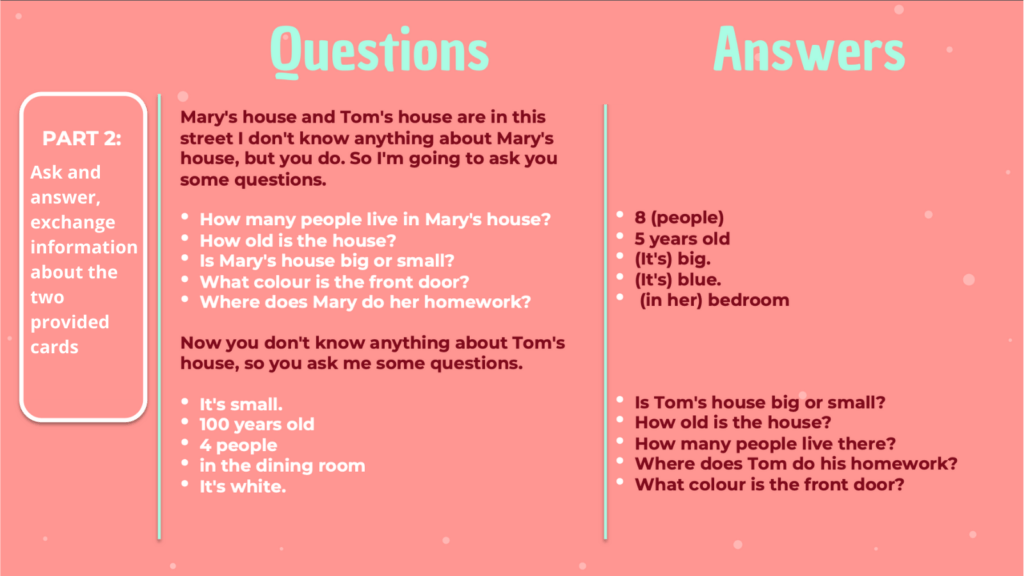
Guidelines for the task:
In Part 2, the examiner may ask simple questions to inquire about information regarding people, objects, and situations (time, place, age, appearance, etc.). The types of questions the examiner uses include:
| Question types | Example |
|---|---|
| Questions with question words like “Who, What, When, Where, How old, How many, etc.“ | What is the name of Robert’s favorite restaurant? |
| Yes/ No questions | Has Harry’s teacher got a car? |
| Multiple-choice questions | Is the restaurant cheap or expensive? |
3.3. Speaking Part 3
In this part of the test, the examiner presents pictures that depict a story and describes the first picture. The candidate continues the story by describing the remaining 3 pictures. The story’s title and characters are provided in advance.
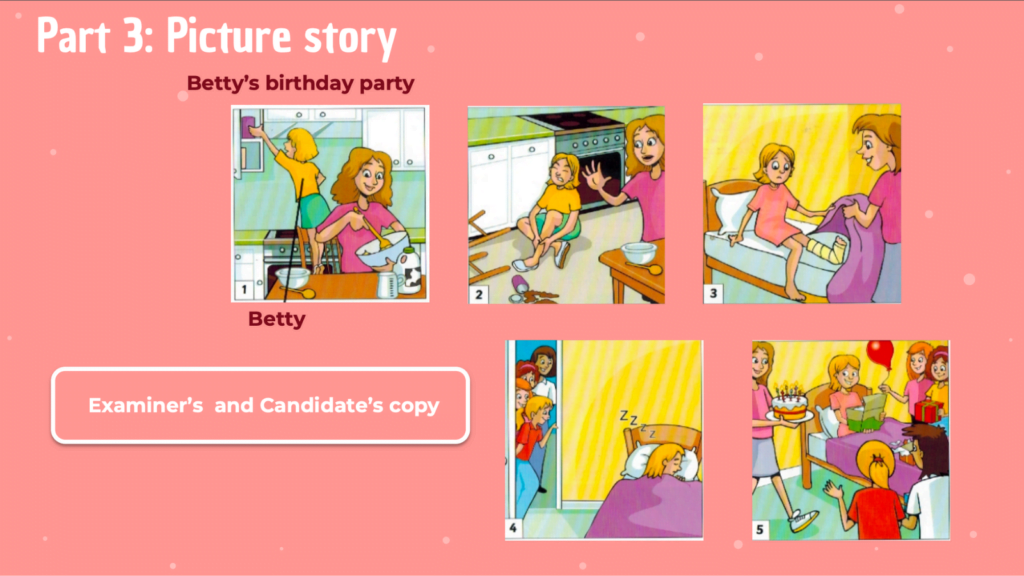
Guidelines for the task:
In Part 3, candidates are required to tell a simple story based on the given images. However, this doesn’t demand advanced storytelling skills. Candidates only need to say a few words about each picture and are not required to provide elaborate narrations.
Candidates should go through each image in sequence to get a general understanding of the story before beginning to speak. They shouldn’t worry if they can’t construct a complete story with lengthy sentences because merely describing the pictures with a few words meets the requirements, and the examiner will provide suggestions if needed.
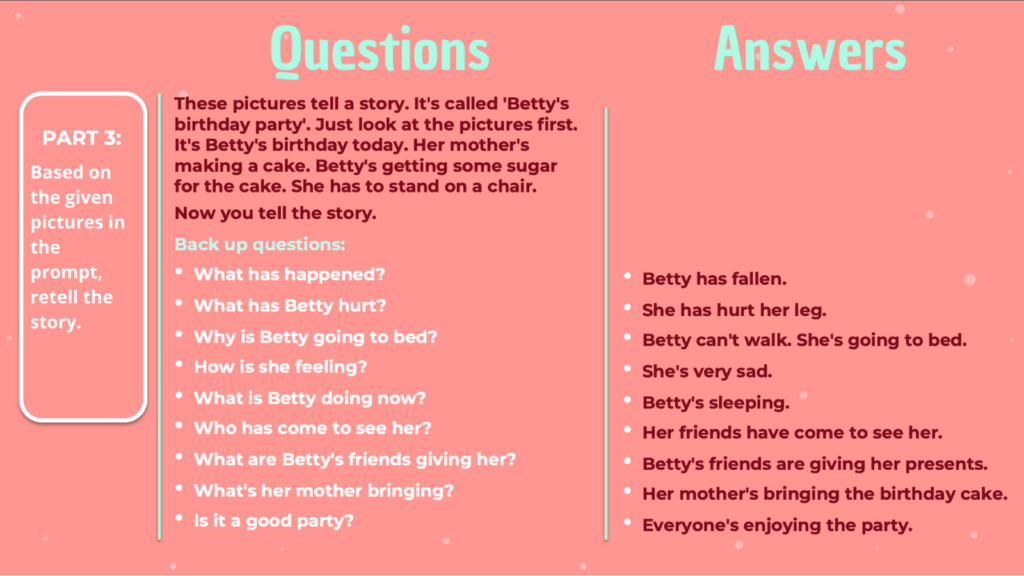
Common structures used in this part include:
- There is/are…
- Be and have (got) in the present tense.
- Can/can’t do something.
- Must/mustn’t do something.
- Present continuous tense for some verbs indicating actions like come, go, buy, put on, carry, open, laugh, look, etc.
- Present perfect tense.
Candidates should practice saying simple sentences like “There is a big present for David” or “He’s playing the drums very loudly” and describe simple emotions like “David’s excited.“
3.4. Speaking part 4
The examiner asks the candidate questions related to the candidate’s self, for example, about school, hobbies, birthdays, or family vacations.
Guidelines for the task:
Candidates should feel confident when answering questions about themselves, family and friends, home, school, and activities they typically do in their free time, their likes and dislikes, as well as other topics related to their daily life.
The examiner may ask questions such as:
- What time do you get up on Saturday?
- What do you do on Saturday afternoon?
Candidates can respond with simple answers or short phrases, one or two short sentences.
Typically, questions will be in the present tense, but candidates should also prepare their grammar knowledge of the past tense, present perfect, and the “be going to” structure to answer questions like “What they did yesterday?” or “What are you going to do at the weekend?“
Questions and example answers for Part 4:
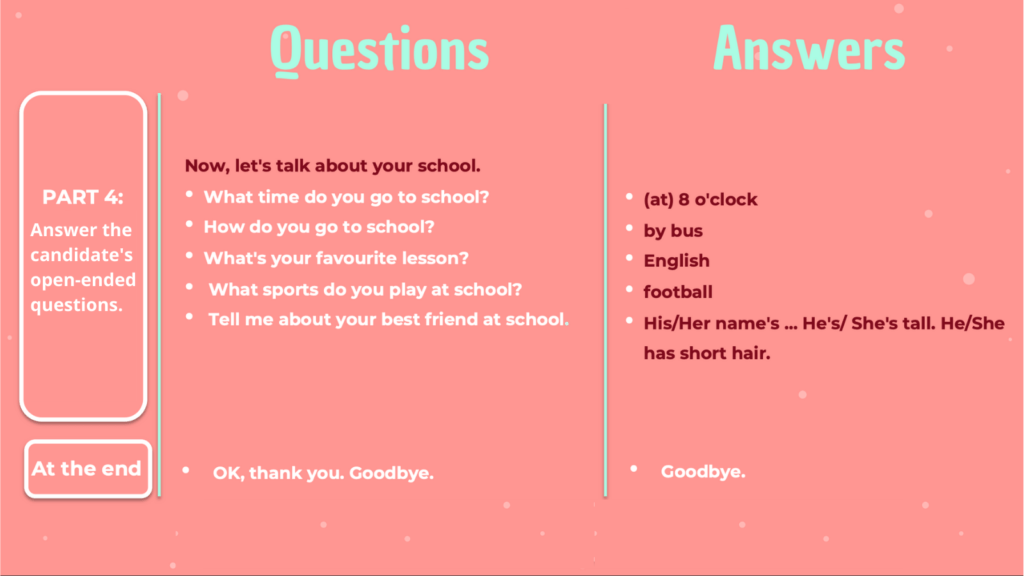
Parents can download the question and sample answer file for the Flyers exam below
4. Flyers Speaking practice video
Here is a video of the Flyers Speaking test by Jacopo from Cambridge:
Examinar’s comments and grading on Jacopo’s Speaking test:
Additionally, FLYER also offers a series of Speaking practice videos (5 episodes) that simulate a real Cambridge Flyers Speaking test. Parents can refer to these videos to further support their children’s preparation at home.
5. 200+ Cambridge Flyers practice tests on the virtual testing platform
The FLYER Virtual English Testing Platform offers 200+ A2 Flyers Cambridge exam practice tests (covering all parts: Listening, Reading & Writing, and Speaking) to provide your child with preparation for the Cambridge Starters exam.
- These exams have been carefully compiled to match the format (up to 90%) following Cambridge’s latest standards.
- The automatic scoring system and answer key will help students review and study effectively at home.
- Interactive exercises and game simulations stimulate children’s brain activity and interest in learning.
- It offers various fun learning features such as challenges with friends, short practice exercises, and vocabulary reviews.
For the speaking test, students will listen to audio with a native English-speaking teacher’s voice and record their answers directly in the test. By accessing the virtual exam room on a phone, tablet, or computer, students can freely practice with a vast collection of practice tests from FLYER.
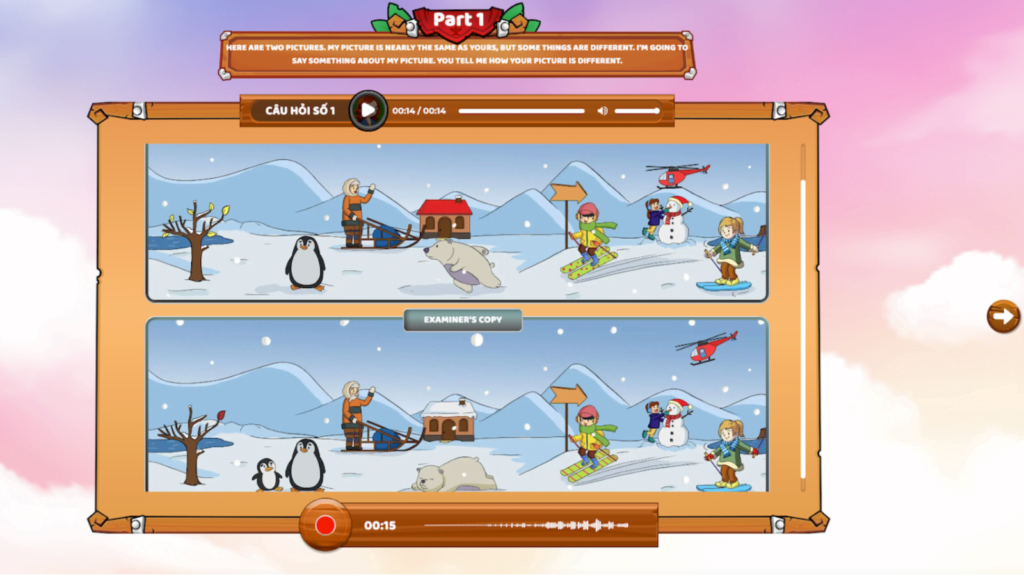
Moreover, a helpful feature for parents is the Learning Report, which makes it easy to track the progress of their children’s studies. The system automatically stores all test results and uses them to provide feedback on the student’s current proficiency level, strengths, and areas that require improvement.
More significantly, parents who use FLYER’s virtual testing platform can save up to 80% on their kids’ exam preparation expenses!
Conclusion
With the comprehensive material that FLYER has supplied above, we hope that students will be able to adequately prepare for and do well on the forthcoming Cambridge Flyers exam!
Read more



